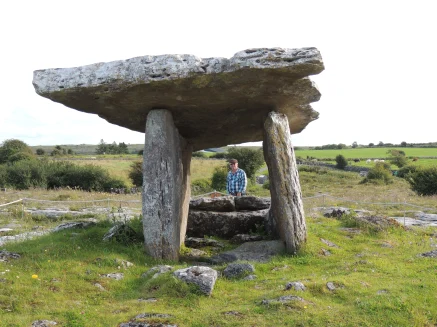
What is a Dolmen? It is a portal tomb where many people are laid to rest, along with some belongings. In ancient times it would have been covered with dirt, the entrance was below the capstone.
This Dolmen is in Co. Clare, in an area known as The Burren. There is a tangible sense of ancientness in The Burren, and with good reason – there are about 90 tombs and over 500 stoneforts or buildings. Interestingly, many of these are in farmer’s fields and you will need to climb fences and hike through rocks and cows to find them.
Poulnabrone, however, is right on the side of the road with a parking lot for convenience. (There is a stonefort down the road too, but it is one that has an entrance fee and an opening and closing time.)
The first time we visited, there was a local making and selling jewelry. He was a treasure trove of knowledge and more than willing to share his knowledge. It was October; he said in the summer he dressed up as a druid and told tales. I was looking forward to seeing him when we revisited in August, but, alas, he was not there.
There is not an entrance fee and you are welcome to wander around, though there is a rope around the Dolmen to protect it. The wandering is somewhat treacherous because of the huge, uneven limestone covering the ground.
According to the plaques located at the site, Poulnabrone Dolmen dates to about 3,000 BC. In doing repairs they discovered the remains of thirty three people; adults and children. It looks like (and this is for all of Dolmens in Ireland) that people died in other places and their remains were later to the portal.
Arrow heads, polished axes, stone beads, quartz crystal, and pottery were found with the remains.
Since a portal is a gateway, I imagine that the belief would be to bring your dead so that they can enter the next life. Maybe they had a sacred ceremony at certain times of the year, bringing their loved one’s remains to be buried on sacred ground. Perhaps a druid oversaw the ceremony. I can envision family members going to the portal to commune with those who passed on also, seeking advise or blessings. Though I’m not sure I’d like to carry a family members bones with me…did they bury them, then dig them up? Or have a special place where they bodies decomposed, then gather them? Was it an event where tribes from all over came or was it a single tribe or even family?
What are your thoughts? I’d love some more speculation!



Sounds interesting! I’d love to visit the Burren. Was there a feel on ancient-ness? I think they only would take the leaders of the clans there because if they took everyone, it would be a person’s sole job? Interesting. Were there dolmens in other parts of Ireland? …or just in Co. Claire?
LikeLike
Those in the know think it was only the elite who are buried in the Dolmens. There are Dolmens all over Ireland, but The Burren seems to have the most. Some tourist just run from site to site and get their pictures, but if you take a moment to be still you can feel the ancient seep into you, like the mist, enveloping you.
LikeLike
I visited this particular doleman and I would agree that there is a sense of ancientness about it and other parts of the Burren. It feels sacred almost, maybe because so many were buried there. It’s almost like it was a place of remembering the great ones. I like the idea that at certain times of the year the living would meet their loved ones at the portal of the dolman to seek advice or blessings from those who had gone before. Of course, it’s so old we have no way of knowing for sure. But it seems ceremonial in nature and created to honor those who had died or to assist them to the other side? Very incredible that they are still standing after so many centuries. It makes me wonder how they created them with such large stones and primitive tools in the first place! It’s a must see if you’re ever in the Burren. And as mentioned above, walk carefully across the limestone that has eroded leaving deep ruts in the rock surrounding these ancient wonders.
LikeLike